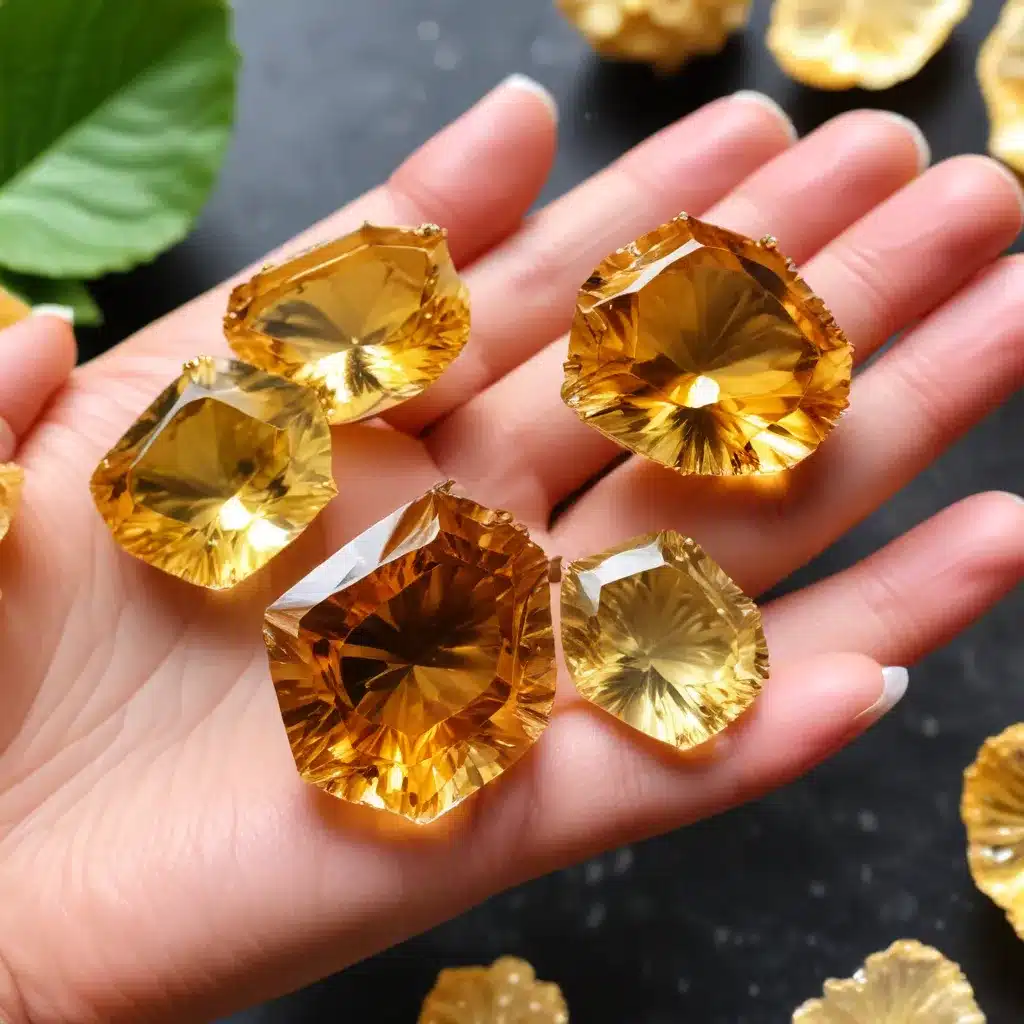
Citrine, often referred to as the “success stone,” is one of the most sought-after quartz varieties in the world. With its radiant, sunny hues and dazzling brilliance, this captivating gem has long been a favorite among jewelry lovers and crystal enthusiasts alike. But what exactly gives citrine its signature sparkle? The answer lies in the intricate science behind the formation of this stunning yellow gemstone.
Citrine Composition and Structure
At its core, citrine is a crystalline form of quartz, the second most abundant mineral on Earth’s surface. Quartz is a silicon dioxide (SiO₂) compound, and citrine is distinguished by the presence of trace amounts of iron within its crystal structure. This iron content is what gives citrine its distinctive golden-yellow to brownish-orange hues, ranging from pale lemon to deep amber.
The crystalline structure of citrine is formed by the tetrahedral arrangement of silicon and oxygen atoms. The silicon atoms are surrounded by four oxygen atoms, creating a stable and symmetrical lattice pattern. This orderly arrangement is what gives quartz and its varieties, including citrine, their characteristic transparent to translucent appearance and remarkable durability.
The Formation of Natural Citrine
Citrine’s natural formation is a testament to the dynamic processes that shape our planet. Geologically, citrine is typically found in hydrothermal veins, pegmatites, and granite formations, where it forms under specific temperature and pressure conditions. The yellow coloration is a result of the oxidation of iron impurities within the quartz crystal structure, which occurs when the mineral is exposed to moderate heat.
Natural variations in citrine can be attributed to the unique geological environments in which it forms. Factors such as the presence of other minerals, the duration of the heating process, and the rate of cooling all contribute to the diversity of colors and clarity levels observed in natural citrine specimens.
The Process of Lab-Grown Citrine
As the demand for citrine has grown, scientists and gemologists have developed techniques to cultivate this captivating gem in a controlled laboratory setting. The process of creating lab-grown citrine involves carefully replicating the natural conditions that give rise to this quartz variety.
One of the primary methods used to synthesize citrine is the hydrothermal process, which mimics the high-temperature, high-pressure environments found in nature. In this technique, a nutrient solution containing the necessary silicon and iron components is placed in a sealed chamber and subjected to sustained heat and pressure. Over time, the quartz crystals form and develop their signature yellow coloration.
Another approach is the flame-fusion method, also known as the Verneuil process. This technique involves melting quartz powder and then allowing the molten material to slowly cool and crystallize, resulting in the formation of synthetic citrine.
Compared to their natural counterparts, lab-grown citrine exhibits a high degree of consistency in color, clarity, and overall quality. By carefully controlling the environmental factors during the synthesis process, gemologists can produce citrine with a stunning, uniform appearance that rivals or even exceeds the beauty of natural specimens.
Optical Properties of Citrine
One of the most captivating aspects of citrine is its remarkable optical properties. The refractive index of citrine, which measures the extent to which light bends as it passes through the material, is typically around 1.544 to 1.553. This relatively high refractive index contributes to the gem’s brilliant, sparkling appearance.
The color of citrine can also vary significantly, ranging from pale yellow to deep, rich amber. This diversity is a result of the varying levels of iron impurities within the quartz crystal structure. Additionally, the dispersion of light within citrine, which determines the gem’s ability to break white light into its component colors, is relatively low compared to other gemstones, giving citrine a more focused and uniform sparkle.
Citrine Applications and Uses
Citrine’s unique properties and striking appearance have made it a versatile and highly sought-after gemstone for a wide range of applications. In the jewelry industry, citrine is a popular choice for engagement rings, pendants, earrings, and other elegant accessories. The gem’s durability, combined with its brilliant luster, makes it an appealing option for daily wear.
Beyond its decorative uses, citrine also finds application in various industrial and technological fields. The gem’s piezoelectric properties, which allow it to generate an electric charge when subjected to mechanical stress, make it useful in the production of certain electronic devices and components.
Citrine’s captivating appearance and associations with success, prosperity, and creativity have also made it a popular choice in the world of spiritual and metaphysical practices. Many believe that wearing or carrying citrine can help promote positivity, personal growth, and self-confidence.
The Future of Lab-Grown Citrine
As technology continues to advance, the production of high-quality, lab-grown citrine is expected to grow in both scale and sophistication. Researchers and gemologists are constantly exploring new synthesis techniques to create citrine with even greater consistency, clarity, and color purity.
Moreover, the growing demand for ethical and sustainable gemstone options has driven the exploration of lab-grown citrine as a more environmentally friendly alternative to mining natural deposits. By carefully controlling the production process, lab-grown citrine can be produced with a significantly reduced environmental impact, making it an increasingly attractive choice for conscious consumers.
As the world of gemstones continues to evolve, the future of lab-grown citrine looks bright. With its captivating sparkle, versatile applications, and the potential for more sustainable production, this sunny-hued quartz variety is poised to remain a beloved and sought-after gem for years to come.

